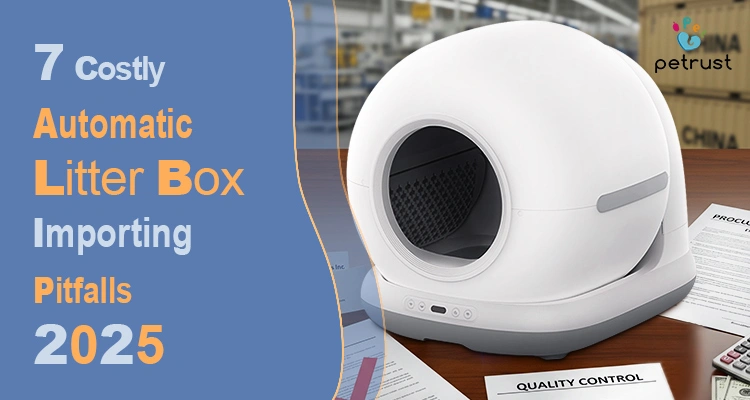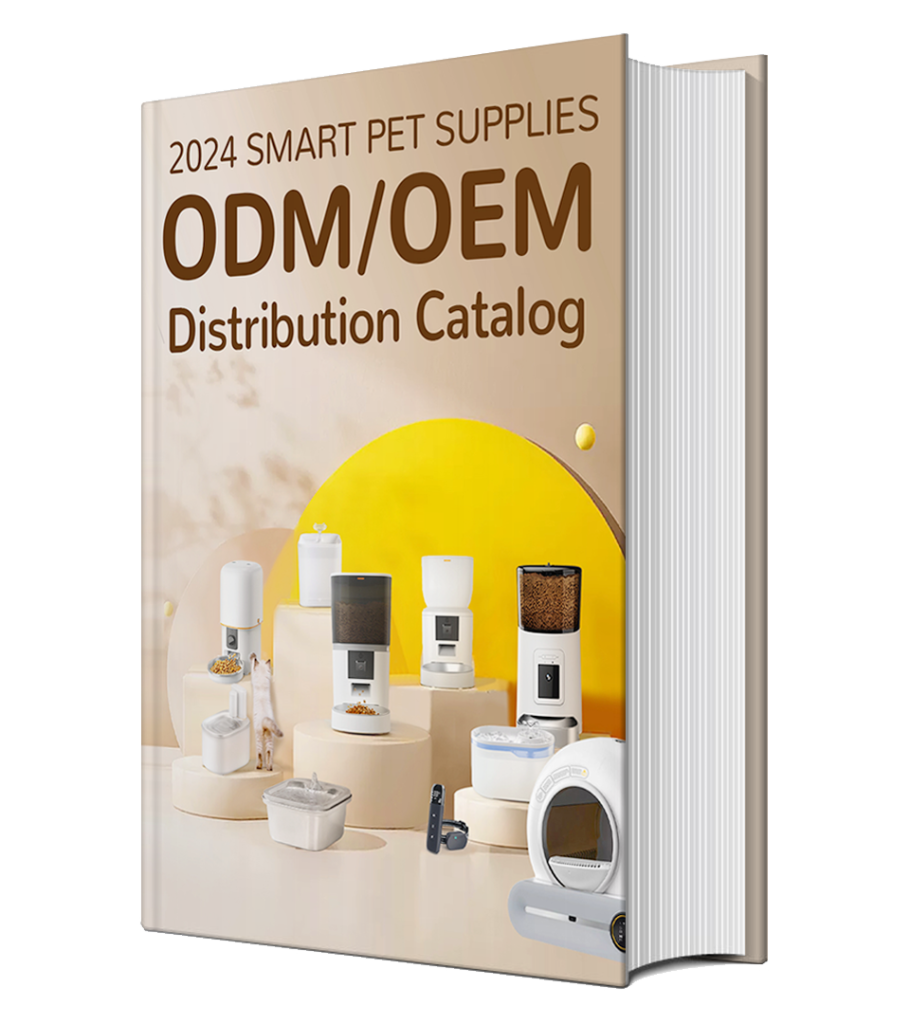Import automatic litter box from China? It sounds like a promising way to grow your pet brand, but behind that promise often hides a maze of unexpected challenges. You’re not alone if you’ve faced frustrating delays, surprise costs, or worse—received products that just don’t meet your quality standards.
Many brands have learned the hard way that importing smart litter boxes isn’t just about placing an order—it’s about navigating a complex landscape filled with hidden pitfalls that can quickly drain your budget and patience.
Take Sarah, a US-based pet entrepreneur, who excitedly placed a big order only to find her smart automatic litter box arriving with faulty sensors and weak odor control. The recall that followed wasn’t just expensive—it put her brand’s hard-earned reputation on the line. Unfortunately, stories like hers aren’t rare in this industry.
In this guide, we’ll walk you through the 7 costly pitfalls you absolutely need to avoid in 2025 if you want to import automatic litter box from China smoothly and successfully.
Plus, we’ll highlight the latest innovations—like app-enabled controls, whisper-quiet motors, and environmentally friendly materials—that are changing the game for pet care brands everywhere.
Ready for the full roadmap? Dive into our Ultimate Guide to Import Smart Cat Litter Box from China (2025 Edition) and get started with confidence.
⚠️ 1: Common Mistakes When You Import Automatic Litter Box from China
Navigating the world of importing automatic litter boxes from China can be tricky—even experienced importers sometimes stumble. Many find themselves caught off guard by supplier misrepresentations or overlook critical due diligence steps.
These are classic automatic litter box importing pitfalls that can throw your entire project off track and drain both your time and budget.
Misunderstanding Factory vs Trading Company
John, a seasoned buyer from Europe, thought he had found a reliable factory to manufacture his smart Cat litter boxes.
Weeks of negotiations and planning later, he discovered the “factory” was actually a trading company reselling products with steep markups and little after-sales support. This misunderstanding cost John valuable launch time and caused avoidable stress.
Before making any commitments, take the time to verify your supplier’s status. Request official business licenses, factory photos, and even consider on-site audits or virtual factory tours.
Tools like our supplier verification checklist can help you ask the right questions and avoid costly mistakes.
Trusting Surface-Level Certifications or Website Claims
It’s common to see suppliers proudly display “certified” badges or glowing reviews on their websites. Unfortunately, many of these claims are outdated, misleading, or outright fake. Relying on surface-level information can leave you vulnerable to product recalls or shipment holds.
Always ask for authentic factory documents and up-to-date audit reports. When in doubt, bring in trusted third-party inspectors or labs to verify the certifications. Protecting your brand starts with confirming your supplier’s claims before placing large orders.
What to Ask Before You Import Automatic Litter Box from China
Preparation is key. Having a clear, detailed questionnaire can make all the difference when selecting your supplier. Cover essential areas such as product specifications, certification status, OEM and ODM capabilities, quality control processes, and after-sales support.
If you’re not sure where to start, our comprehensive guide on finding the best automatic litter box supplier in China offers a step-by-step framework to help you ask the right questions and make confident decisions.
💸 #2: The Hidden Costs That Can Blow Up Your Budget
Sometimes, a low price quote feels like a breath of fresh air—but beneath that tempting number can lie expensive surprises. Many importers overlook these hidden costs, making this one of the trickiest automatic litter box importing pitfalls to navigate.
The MOQ and Mold Fee Trap
It’s tempting to jump at a supplier offering a low per-unit price, but some come with strings attached—like high minimum order quantities (MOQs) or separate mold and tooling fees that don’t show up in the initial quote.
Emily, a startup founder, found herself stuck with far more inventory than she could sell after agreeing to a large MOQ without fully understanding the costs involved. That excess stock tied up her cash flow and created months of stress.
Unpacking a “Too-Good-To-Be-True” Quote
A shiny low price is just the starting point. To truly understand what you’re paying for, it’s essential to get a detailed, line-item quote.
This should cover materials, packaging, software integration, certifications, and even after-sales support. Overlooking any of these can lead to a final bill that’s far higher than you expected—turning a bargain into a budget breaker.
What’s Actually Included in “FOB” or “DDP” Shipping Terms?
Shipping terms can be a real source of confusion. Many buyers aren’t fully clear on the difference between FOB (Free on Board) and DDP (Delivered Duty Paid), which can lead to surprise fees during customs clearance or delivery.
Understanding these terms upfront means no unexpected costs later. For a thorough breakdown, take a look at our automatic litter box import duties & customs clearance guide.
🧪 #3: Skipping Samples: A Costly Shortcut You Can’t Afford
Many brands are eager to jump straight into bulk orders to save time and money, but skipping thorough sample testing is one of the most common and expensive automatic litter box importing pitfalls.
Without testing, small issues that seem harmless in prototypes can turn into major problems after production—leading to frustrated customers, costly recalls, and damaged reputations.
Real Sample ≠ Final Product
It’s important to remember that the sample you receive at the start is often a hand-assembled prototype, which doesn’t always reflect the quality of the full production run.
Many hidden defects only show up when products are made at scale. Without rigorous sample testing, you’re essentially taking a blind risk—one that could cost your business time, money, and trust.
How to Properly Request Samples from Chinese Suppliers
Clear communication is key when requesting samples. Be specific about what matters most to your brand—whether that’s the materials used, sensor accuracy, seamless app syncing, or odor control effectiveness.
Setting detailed expectations upfront helps avoid misunderstandings and ensures you get samples that truly represent what you’ll receive in bulk. For best practices, learn how to request and evaluate samples like a seasoned importer.
Importing Smart Litter Boxes? Why Sample Testing Is Critical
Testing isn’t just about looks—it’s about function. Pay close attention to critical features such as motor noise levels, sensor response times, and app connectivity stability.
Catching these issues early means avoiding expensive recalls and unhappy customers down the line. Taking the time to thoroughly test samples is an investment that pays off in peace of mind and smoother product launches.
📄 #4: Certification Risks When You Import Automatic Litter Box from China
One of the most frustrating hurdles many brands face when importing automatic litter boxes from China is navigating the maze of certifications. It’s not just paperwork—it’s a crucial step that can make or break your shipment and product launch.
Delays, blocked shipments, or worse, products barred from sale because of certification issues, are unfortunately common pitfalls that catch many off guard.
CE, FCC, FDA — Which Ones Matter for Your Market?
A recent report from the Global Pet Industry Association revealed that over 30% of smart pet devices failed their initial certification inspections in 2024. This isn’t a small number — it means nearly a third of products hit roadblocks that could have been avoided with proper planning.
In 2025, meeting key certifications like CE for Europe, FCC for the US, and FDA approval for certain materials is more important than ever.
The landscape is evolving quickly—today’s smart litter boxes don’t just need basic electrical safety. Many now require certifications covering app security features and energy efficiency to satisfy stricter regulations and consumer expectations.
How to Spot a Faked Test Report
Faked or outdated certification reports are unfortunately common in the market. It’s easy to be misled by glossy documents that look official but fail under scrutiny.
Always take the time to verify test reports directly with the issuing labs. Look closely for inconsistencies such as mismatched logos, incorrect serial numbers, or vague test parameters.
Getting Third-Party Lab Verification (the Safe Way)
The most reliable path is to work with trusted third-party testing agencies like SGS, TÜV, or Intertek. These organizations offer thorough product testing and certification services that provide peace of mind before you ship your order.
Investing in proper lab verification early on might seem like an extra step, but it can prevent major headaches down the line.
🛠️ #5: Quality Control Mistakes That Can Wreck Your Bulk Orders
Quality control is often the last thing on the checklist when you’re rushing to get your automatic litter boxes imported—and overlooking it can lead to some of the most painful and costly mistakes in your entire import journey.
Why Skipping Pre-Shipment Inspection Is Riskier Than You Think
Having a trusted third-party inspection before your products leave the factory isn’t just a nice-to-have—it’s essential. These inspections catch issues that might not be visible in sample phases but could turn into a nightmare for your customers once the bulk order arrives.
Reputable labs like SGS specialize in smart device quality control, helping ensure your automatic litter boxes meet the promised standards before they’re shipped.
How Video Factory Audits Give You a Clearer Picture
Sometimes, a quick call can save you thousands. Video factory audits let you see the production process in real time—from assembly lines to soldering details and even packaging.
It’s a powerful way to build confidence in your supplier and spot red flags early, especially when you can’t visit the factory in person.
The Power of a Detailed QC Checklist
A quality control checklist isn’t just a formality—it’s your safety net. Make sure to include critical functions like waste detection sensors, rotation cycles, and door locking mechanisms. The more detailed your checklist, the less room there is for surprises after your shipment arrives.
🕒 #6: Import Timeline Delays and How to Avoid Them
Getting your product launch timeline wrong doesn’t just cause headaches—it can lead to serious financial setbacks and lost opportunities. In the world of importing automatic litter boxes, timing missteps are one of the most common and costly pitfalls to watch for.
Understanding the realities behind production and shipping schedules is key to keeping your project on track and your budget intact.
Peak Season Shipping Pitfalls
Many buyers underestimate how busy Chinese factories and shipping lines get around peak periods like the Chinese New Year and the holiday rush in Q4. These times often mean production slowdowns and skyrocketing freight costs.
Brands that don’t plan for these seasonal bottlenecks risk frustrating delays that push back launches and disrupt their entire sales calendar.
Building Time Buffers into Your OEM Plan
It’s wise to build a safety net of at least 3 to 4 extra weeks in your production and shipping schedule. These buffers aren’t just padding—they account for the unexpected, like supplier hiccups, customs holdups, or shipping delays.
Having this cushion can make the difference between a smooth product arrival and last-minute scrambling.
Why Communication Breakdown = Missed Deadlines
Strong, clear communication between you and your supplier is the glue that holds your timeline together. Without well-documented milestones and timely updates, even small issues can balloon into major setbacks.
Regular check-ins and clear expectations help prevent surprises, ensuring your order moves steadily from factory floor to your warehouse.
For a deeper dive on managing shipments and avoiding costly delays, explore our guide on how to ship automatic litter boxes from China without overpaying.
✅ #7: Best Practices to Import Automatic Litter Box from China in 2025
Navigating the import process can feel overwhelming, especially with so many stories of costly mistakes out there. Yet, many of these hurdles become manageable once you know what to look out for and how to prepare.
Following proven best practices will help you dodge the most frequent automatic litter box importing pitfalls and bring your products to market with confidence.
Red Flags to Watch for Before You Place Your Order
When a supplier’s product details are vague or inconsistent, that’s a signal worth paying attention to. Suppliers who hesitate or refuse to provide product samples might be hiding quality issues.
Empty promises like “we’ll fix it later” often mean delays, added costs, or worse—unsatisfactory products. Trust your instincts and ask detailed questions early to avoid surprises later.
Must-Have Terms in Your Purchase Agreement
A clear, thorough purchase agreement is your best protection. Make sure it covers essential points such as delivery deadlines and who bears responsibility for certification compliance.
Don’t forget clauses about quality control rework costs—these can save you from unexpected expenses.
Also, align product specifications with the latest market expectations: low-noise motors, seamless app connectivity, and environmentally friendly packaging are no longer optional—they’re becoming standard.
Bonus: How Petrust® Helps 300+ Brands Avoid These Pitfalls
Partnering with a trusted expert can make all the difference. Petrust® supports over 300 pet brands by providing tailored smart litter box solutions, verified certifications, and a multilingual team dedicated to smooth communication.
Our comprehensive OEM and ODM services are designed to guide you every step of the way—helping you sidestep common pitfalls and bring quality products to your customers without the stress.
Frequently Asked Questions About Importing Smart Litter Boxes
1. What’s the typical landed cost when importing a smart litter box from China?
On average, the landed cost ranges from $35 to $75 per unit. This depends heavily on factors like the product’s technical features, required certifications, and the shipping method you choose. Knowing these details upfront helps you budget smarter and avoid surprises.
2. Are FCC or CE certifications necessary for selling on Amazon FBA?
Absolutely. For smart electronics, Amazon takes certifications seriously and may block listings that lack proper FCC or CE approval. To keep your products compliant and your listings live, it’s important to meet these standards. You can refer to Amazon’s official electronic compliance guidelines for the latest updates.
3. How can I confirm that my supplier is a real manufacturer?
The best way is to request and verify their business license, ISO certificates, and exact factory location. This ensures you’re dealing directly with a manufacturer—not just a middleman—which usually translates to better quality control and pricing.
4. Is private labeling possible on initial orders?
Yes, most factories welcome private labeling starting at minimum order quantities between 300 and 500 units. This gives you the flexibility to build your brand identity without massive upfront commitments.
Final Thoughts on Avoiding Automatic Litter Box Importing Pitfalls
Successfully bringing automatic cat litter boxes from China to your market takes more than just placing an order—it means carefully navigating complex challenges like supplier vetting, certification compliance, quality assurance, and efficient shipping.
Partnering with experienced manufacturers and using a proactive, data-driven approach empowers you to avoid costly mistakes and confidently launch innovative, high-quality products in 2025.
Ready to make your import journey smoother? Book a Free Consultation with Petrust® today and get expert guidance tailored to your business needs.







